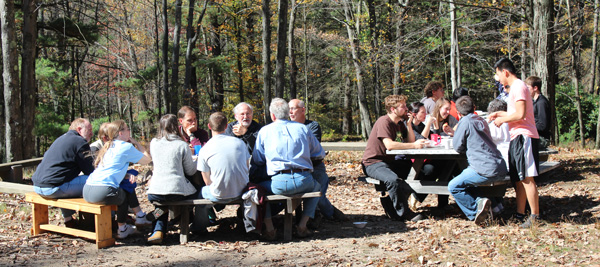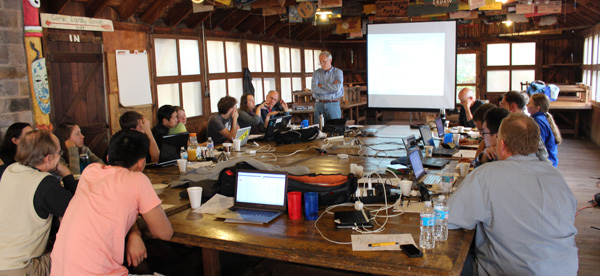
Twenty-five Council members and Representatives gathered for a Shehaqua summit from October 11–13 at Camp Daddy Allen, right across the road from Camp Shehaqua. The purpose of the meeting was to evaluate this year’s programs and discuss ways they can be improved.
But another task was waiting for the summit participants as well: To continue the restructuring of the way the Shehaqua Family is organized, a process that started a year ago with the recruitment of Shehaqua Representatives and the formation of the Shehaqua Council. Executive Director Gregg Noll suggested that the current model of having an executive director and two executive assistant—who have to make a lot of decisions and are involved in many aspects of camp organization—might not be the most effective model. Instead, he suggested, it would be better to allow more people to connect and collaborate in areas that concern and interest them, and so get things done more quickly. Gregg proposed that the Shehaqua Family adopt a circle system, an idea based on the sociocracy model (a system of governance, using consent-based decision making among equivalent individuals; check out Wikipedia for more). A circle would consist of a small group of people (around 5–10) that is responsible for organizing one aspect of Shehaqua.

The summit attendees decided to form nine new circles, one for each of the four Shehaqua programs—Spring Gathering, Family Camp, Harvest Festival, and Winter Retreat—and five more covering the year-round operations: Finances, Operations, Outreach, Afternoon & Evening Activities, and Education. The Shehaqua Council now serves as the “top circle” to connect all the other circles to the Shehaqua Family. Each circle elected a facilitator plus one member (liaison) that connects and reports to the Council Circle.
The responsibility of the four Shehaqua program circles is to first find directors for the different programs and then to support them by establishing guidelines and identifying best practices, as well as to mentor the directors and make sure that they are on top of all preparations for their program. The responsibility of the five operations circles is to create resources (for example, education materials, or checklists for preparatory tasks) for the program directors to help them plan and execute their programs successfully.
Executive Director becomes Council Facilitator
A few weeks before the Summit took place Gregg Noll informed the Shehaqua Council and Representatives that it would be time to look for his successor, as it was in the best interest of Shehaqua to have new leadership every 2–3 years. A Nominations and Elections Circle was formed, and several people were nominated for the position of Executive Director—but none of them accepted. (A couple of the nominees said that they would consider the position in a year or two, once they would have more experience.) Gregg declared that he was willing to serve for another year as Council Facilitator (the position that replaces the Executive Director in the new Shehaqua Leadership structure) if he got confirmed by the Council and the Representatives, as he wanted this to be an elected position. The vote is scheduled for the beginning of November.
Summit attendees: Claude Aubert, Chris Bush, Sunkwon Bush, David Cantrell, Yung Chia, Geoffrey Ching, Haydee Ching, Nathaniel Ching, Igraine Convery, Crescentia DeGoede, Leighton DeGoede, Geoffrey Hinkle, Shota Iwasaki, Matt Learey, Kristine Learey, Kyra Moyer, Gregg Noll, Oliver Noll, Danso Sawamukai, Lara Sawamukai, Rob Sayre, Sally Sayre, Victor Servito, Michael Stewart, Kester Wilkening. Providing delicious food throughout the weekend: Elke Noll and Satomi Aubert.

